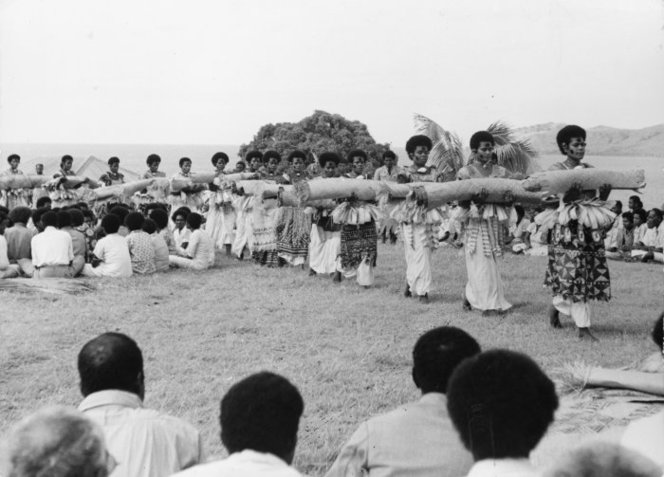
Presentation of Fijian mats and tapa cloths to Queen Elizabeth II
Fiji, Polynesia. 1953 C.E. Multimedia performance (costume; cosmetics, including scent; chant; movement; and pandanus fiber/hibiscus fiber mats), photographic documentation
To show respect and gratitude towards Queen Elizabeth II for visiting Tonga and for commemorating the war memorial. Also I believe this served as a way of the two countries signaling their alliance and partnership.
Form:
Black and white photo of women wearing skirts in a procession
No known photographer
Procession of women
Wearing skirts and holding mats
Skirts are decorated and painted with geometric patterns
Making their way across a grassy open area and through groups of men
Men are wearing primarily white clothing
Women have similar hairstyles (smaller afros) and appear to have face paint/tattoos on their foreheads and cheeks
Function:
The photo depicts a celebration honoring the visit of Queen Elizabeth II
Content:
Procession of women
Their skirts are made of barkcloth and the mats are tapa mats
Barkcloth is also known as masi
Tapa mats are made from the bark of the paper mulberry tree
Men tend to the trees but only women can make the actual fabric
The bark (it is very soft) is cut into strips and beat with a hammer
The women felt the pieces → beat them together to form long plain sheets
The designs are painted onto the cloth by hand
Function of tapa mats: cloth, sheets, capes, cites, gifts (weddings, feasts, important ceremonies, rituals, tributes)
Tapa mats are often presented as gifts to important people
Simplicity indicate importance
More widely available than masi
Context:
On December 17, 1953 the queen visited the Kingdom of Tonga, which was the only Pacific nation to retain a monarchy and was protected by the British government
Fiji, Polynesia
Cloth is presented as a gift in special ceremonies like funerals or weddings and also to commemorate special events
Queen Elizabeth witnessed many Fijian traditions and participated in the kava ceremony
Cross-Cultural Connections:
English colonization and its effects → contact with Europeans
Christianization
Cultural Genocide
Role of women in art
Athenian women created the peplos (a rich outer robe or shawl worn by women in ancient Greece, hanging in loose folds and sometimes drawn over the head) that adorned the statue of the Athena Parthenos in the Parthenon (the statue that disappeared)
Themes:
Gender roles in art
Converging cultures
History/Memory
Performance (ritual and ceremony)
Power and authority
Social commentary
Narrative art
Individual and society
Colonization